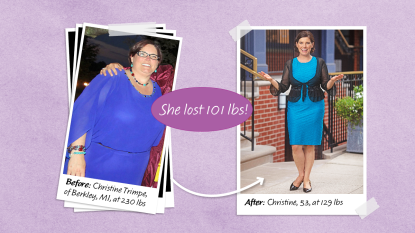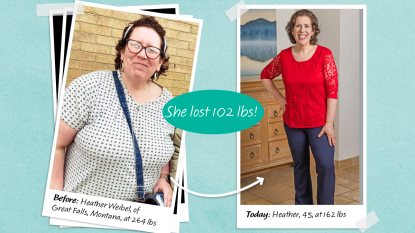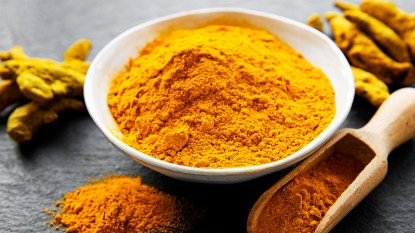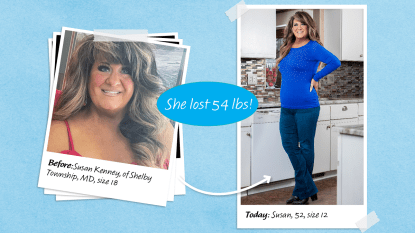How Keto-Cycling Can Give You Even Better Weight-Loss Results
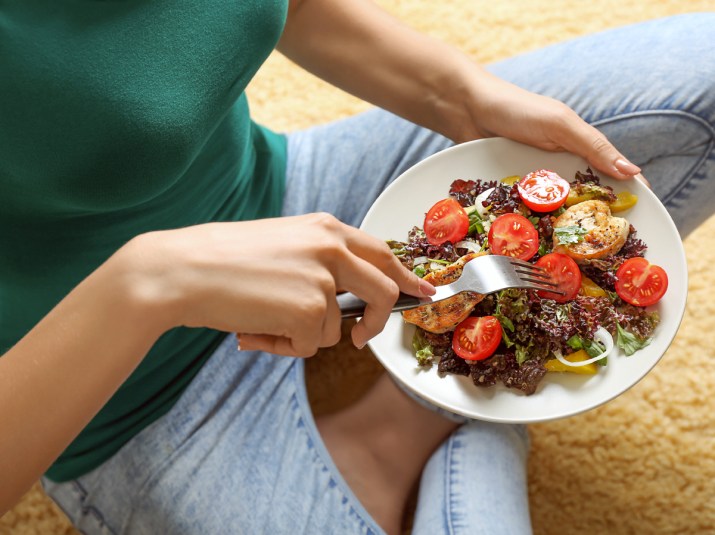
Oxford-educated MD reveals the genius diet-cycling plan that combines the fat-blasting effects of keto with the energy-boosting benefits of carbs, so you’ll drop pounds faster than ever — without deprivation
Keto continues to dominate Google’s most-searched diet terms and Amazon’s bestseller list — and it’s no surprise why! There’s plenty of scientific evidence that a low-carb ketogenic diet works wonders: In the lab, it’s been shown to improve memory by 62 percent, boost mood by 52 percent, and decrease heart-harming triglycerides by 300 percent — and that’s on top of the fact that a recent study in The Journal of Clinical Endocrinology & Metabolism showed that women on a very low-carb diet dropped more than twice as much weight as women on a calorie-restricted diet.
But as anyone who’s tried the keto diet knows, following the food formula is easier said than done. We start off with good intentions, but symptoms like headaches, brain fog, fatigue, and bloat make staying the course difficult — in fact, experts report that 75 percent of women who try a low-carb diet are derailed by such issues. “The keto diet has so many benefits,” says Robert Santos-Prowse, RD, author of The Cyclical Ketogenic Diet: A Healthier, Easier Way to Burn Fat with Intermittent Ketosis ($10.37, Amazon). “But what I hear over and over again is that people just can’t stick with it. Worse, they feel so deprived that when they fall off the keto wagon, they fall hard.”
Why is it so difficult to stick with a keto diet?
Staying in ketosis — the state where the body is exclusively burning fat for fuel — without enjoying carbs for weeks on end puts the body into a metabolic state that mimics starvation, warns osteopathic physician Joseph Mercola, DO, author of KetoFast: Rejuvenate Your Health with a Step-by-Step Guide to Timing Your Ketogenic Meals ($14.01, Amazon). “Long-term ketosis is invariably harmful,” he asserts. “Our bodies are designed for feast and famine, but if you’re in constant famine mode, which you tend to be with continuous ketosis, then your body starts to slow everything — including metabolism — down.” The upshot? The body begins to break down muscle for immediate fuel and hoard fat to stave off starvation. This lowers metabolism and causes a pileup of stubborn pounds.
Fortunately, researchers have uncovered a solution that offers all the benefits of keto without the side effects: keto cycling. It takes the sting off the keto diet by building in “carb breaks” — sanctioned pauses from the extreme restriction of a ketogenic diet — after a one-month keto adjustment period. These breaks make dieting feel less restrictive, and they won’t derail progress toward your weight loss goals. Indeed, says Oxford-trained physician Tommy Wood, MD, a research professor at the University of Washington in Seattle, the body needs carbs to function at its best. “Cycling back in some carbohydrates stimulates your metabolism,” says Dr. Wood. Carb breaks remind the body that it’s not starving, which staves off metabolic slowdowns, energy dips and other uncomfortable symptoms familiar to keto dieters.
Benefits of Keto Cycling
Keto cycling allows you to enjoy carbs two days a week while still getting the benefits of the keto diet — and you can reap even more impressive results simply by eating the majority of your carbs in the afternoon and evening, according to a study published in the journal Obesity. In the study, adults who skimped on carbs in the morning and loaded up in the afternoon and evening lost 120 percent more weight than those who ate carbs throughout the day — plus, they shed 25 percent more inches from their belly and felt less hungry overall. Researchers posit that this carb-timing strategy keeps cortisol levels lower throughout the day to prevent weight gain and promotes the production of sleep-fostering brain chemicals that increase fat burn throughout the night. For best results, enjoy 1⁄2 cup of carbs with lunch and 1 cup of carbs in the evening.
Keto cycling can supercharge fat loss. The reason? Unlike traditional calorie-restricted diets, keto cycling helps you burn stored fat while retaining metabolism-revving lean muscle. “When you cycle carb restriction with periods of replenishment, over time, more of that weight loss is fat and less of it is muscle,” explains Wood. “You end up with a more efficient metabolism than you would have through calorie restriction alone.” Indeed, in a randomized trial published in the European Journal of Clinical Nutrition, subjects who alternated between periods of fasting and feasting lost 11 percent of their fat mass and gained 2 pounds of muscle after 10 weeks.
The results go beyond deprivation-proof slimming. “Keto cycling can literally change your body at a cellular level,” asserts Santos-Prowse. Research shows it can improve blood sugar by 25 percent while boosting immunity and reducing body-wide inflammation. “Normally when I diet, I’m a puffy, bloated mess, but this was different,” says 28-year-old keto-cycler Lauren Breeze. “I could name my health benefits all day long, there are so many.”
Keto cycling optimizes the body’s fat-burning systems. “Keto cycling teaches your body to efficiently burn fat for fuel,” says Dr. Mercola. And, he promises, you won’t ever feel deprived: “It’s a more balanced approach.” Indeed, after the initial 30 days, you’ll enjoy metabolism-revving, mood-boosting carbs, making the plan easy to stick to.
Power off pounds with keto meals
During phase one of the keto cycling diet, you’ll follow a strict ketogenic diet for 30 days. That means you’ll replace most of the carbs you’d usually eat with natural, healthy fats, says Mercola. “When you replace carbs with fat, you activate the body’s ability to burn body fat for fuel.”
To do: At each meal, fill at least 1⁄3 of your plate with non-starchy vegetables like leafy greens and asparagus as well as cruciferous veggies like broccoli. For best results, Mercola suggests choosing organic produce when possible to sidestep toxins that may stall weight loss. You’ll also add 4 oz. of lean protein (a serving about the size of a deck of cards) from grass-fed meat, pasture-raised poultry or wild-caught fish; 1 cage-free egg; or 8 oz. of bone broth. To ensure you’re getting enough fat, Mercola recommends including a generous portion of olive oil, coconut oil, coconut milk, grass-fed butter, avocados, palm oil, nuts, or seeds at each meal. There’s no need to keep track of how much you’re eating at this stage, assures keto expert Dr. Santos-Prowse, because fat is naturally satisfying, so you’ll eat less without even trying.
Staving off mineral deficiencies is key to fending off keto flu symptoms (like headaches and low energy) during this phase, says Santos-Prowse. To that end, he suggests enjoying at least one serving of magnesium and potassium-rich leafy greens and drinking at least 8 oz. of water spiked with electrolytes each day. You can supplement with a sugar-free electrolyte powder, like Ultima Replenisher ($14.99, Amazon) or make your own by mixing 1⁄2 tsp. of lemon juice, 2 tsp. of salt, 1 tsp. of potassium salt, and 4 tsp. of vitamin C powder into 32 oz. of water. If these tactics don’t help prevent keto-flu symptoms, Eric Berg, DC, suggests sprinkling 1 tsp. of unfortified nutritional yeast on at least two meals every day: The combination of B vitamins and minerals in nutritional yeast work synergistically to regulate electrolyte balance throughout the body.
By following this simple blueprint, Santos-Prowse says you can expect to lose up to 10 pounds in the first week and about 3 pounds a week after that before moving to phase two.
Supercharge metabolism with carb breaks
During phase two, you’ll cycle between five days of keto eating and two “carb break” days. Santos-Prowse recommends enjoying your carb breaks consecutively to maximize the amount of time you spend in ketosis. But when you take your carb breaks is entirely up to you. “The pattern doesn’t need to be static,” he says. “Since you trained your body to burn fat efficiently during the first phase, you should be able to switch between burning fat and burning carbs easily and quickly, so you can get the life-changing benefits of ketosis while still being able to enjoy all aspects of special occasions with your friends and family. Have yourself a treat and live your life.”
To do: When it comes to carbs, you want to eat about 70 grams spread throughout the day.
Choose healthy sources, like fruit (1 cup of berries contains about 10 grams while sweeter fruit like mango or pineapple are closer to 20 grams per cup), sweet potatoes (about 30 grams per cup), rice (45 grams per cup), quinoa (40 grams per cup), and oatmeal (30 grams per cup).
In addition, you’ll continue to fill at least 1/3 of your plate with non-starchy veggies, and to balance out the extra calories from carbs, add no more than 1 Tbs. of healthy fats to each meal. Finally, you’ll enjoy up to 8 oz. of lean protein (a serving the size of two decks of cards, 2 eggs or 2 cups of bone broth) at each meal. Why so much protein? The extra amino acids help dial down hunger so you don’t struggle to stick with the plan. Wood explains, “When you’re bringing back some carbs, you have to dial back the fat and increase your protein a bit.”
For even faster results, Mercola suggests selecting carbs like underripe bananas, papayas, and mangos, all of which are high in resistant starch a form of carbohydrate that cannot be broken down by the body but has been shown to increase post-meal metabolism by as much as 70 percent for three hours. “These starches turn into short-chain fatty acids in the gut, and they actually get converted into ketones, which helps the body switch in and out of ketosis more easily,” explains Mercola.
Prefer more savory carbs? You can dial up the amount of resistant starch in rice or boiled potatoes with one simple cooking hack: Add 1 tsp. of coconut oil to the cooking water, then cool for 12 hours before reheating. Research shows this simple tweak changes starch at a molecular level, increasing the resistant starch in rice tenfold and reducing its calories by as much as 60 percent.
You can stick with phase two of this plan as long as you’d like, Santos-Prowse says. “Continue with the practice as long as you need until you’re happy with your body composition.”
Sample Meals
Fritatta: Sauté sliced zucchini and tomatoes in olive oil until soft. Add 3 eggs, beaten with 3 Tbs. of milk. Cook on low until eggs set.
Shrimp bowl: Sauté 8 oz. of shrimp, 1⁄2 cup of green beans, and a handful of spinach in 1 Tbs. of olive oil. Serve with 3⁄4 cup of cooked white rice.
This story originally appeared in our print magazine.
We write about products we think our readers will like. If you buy them, we get a small share of the revenue from the supplier.
More From FIRST
The Best Keto Meal Plans to Keep Your Diet Delicious and Doable
A 3-Day Keto Egg Fast Can Help You Revive a Weight Loss Slump






